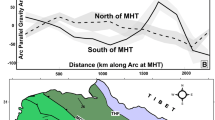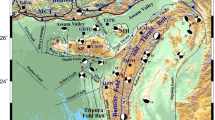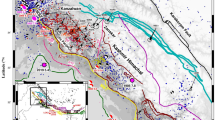Abstract
Surface measurements of crustal deformation and their modelling provide insights into the subsurface earthquake processes at depth. In this article we review the available geodetic measurements of crustal deformation which spans the interseismic, coseismic and postseismic phases of earthquake cycle corresponding to the 2004 Sumatra Andaman earthquake. The GPS measurements of interseismic period (during the preceding 10 year period from the 2004 Sumatra Andaman earthquake) show evidence of strain accumulation in the Andaman region. Coseismic offsets due to the 2004 earthquake are overwhelming which reach up to whopping 7 m and imply that coseismic slip at the plate boundary interface reach up to 15–20 m. Following the earthquake, the region experienced large postseismic deformation which is continuing even now, particularly in the Nicobar and Sumatra region. Total postseismic deformation until the end of 2016 corresponds to an earthquake of Mw 8.5. Aftershocks corresponds to less than 15% of this estimate, thus majority of the deformation is aseismic.
Access this chapter
Tax calculation will be finalised at checkout
Purchases are for personal use only
Similar content being viewed by others
References
Altamimi Z, Collilieux X, Métivier L (2011) ITRF2008: an improved solution of the international terrestrial reference frame. J Geodesy. https://doi.org/10.1007/s00190-011-0444-4
Ammon C et al (2005) Rupture process of the 2004 Sumatra-Andaman earthquake. Science 308:1133–1139
Banerjee P, Pollitz F, Bürgmann R (2005) Size and duration of the great 2004 Sumatra-Andaman earthquake from far-field static offsets. Science 308:1769–1772
Banerjee P, Pollitz F, Nagarajan B, Bürgmann R (2007) Coseismic slip distributions of the 26 December 2006 Sumatra-Andaman and 28 March 2005 Nias earthquakes from GPS static offsets. Bull Seismol Soc Am 97:S86–S102
Bock Y, Prawirodirdjo L, Genrich JF, Stevens CW, McCaffrey R, Subarya C, Puntodewo SSO, Calais E (2003) Crustal motion in Indonesia from global positioning system measurements. J Geophys Res 108(B8):2367. https://doi.org/10.1029/2001JB000324
Catherine JK, Gahalaut VK, Sahu VK (2005) Constraints on rupture of the December 26, 2004, Sumatra earthquake from far-field GPS observations. Earth Planet Sci Lett 237:673–679
Catherine JK, Gahalaut VK, Srinivas N, Kumar S, Nagarajan B (2014) Evidence of strain accumulation in the Andaman region for the giant 2004 Sumatra Andaman Earthquake. Bull Seismol Soc Am 104:587–591. https://doi.org/10.1785/0120130141
Cattin R, Chamot-Rooke N, Pubellier M, Rabaute A, Delescluse M, Vigny C, Fleitout L, Dubernet P (2009) Stress change and effective friction coefficient along the Sumatra-Andaman-Sagaing fault system after the 26 December 2004 (Mw = 9.2) and the 28 March 2005 (Mw = 8.7) earthquakes. Geochem Geophys Geosyst 10:Q03011. https://doi.org/10.1029/2008gc002167
Chlieh M et al (2007) Coseismic slip and afterslip of the great (Mw 9.15) Sumatra-Andaman earthquake of 2004. Bull Seismol Soc Am 97:S152–S173
Curray JR (2005) Tectonics and history of the Andaman sea region. J Asian Earth Sci 25:187–228
Diehl T, Waldhauser F, Cochran JR, Kamesh Raju KA, Seeber L, Schaff D, Engdahl ER (2013) Back-arc extension in the Andaman Sea: tectonic and magmatic processes imaged by high-precision teleseismic double-difference earthquake relocation. J Geophys Res 118:2206–2224. https://doi.org/10.1002/jgrb.50192
Engdahl E, Villasenor A, DeShon H, Thurber C (2007) Telesismic relocation and assessment of seismicity (1918–2005) in the region of the 2004 Mw 9.0 Sumatra-Andaman and 2005 Mw 8.6 Nias Island great earthquakes. Bull Seismol Soc Am 97:S43–S61. https://doi.org/10.1785/0120050614
Fitch TJ (1972) Plate convergence, transcurrent faults and internal deformation adjacent to Southeast Asia and the western Pacific. J Geophys Res 77:4432–4460
Gahalaut VK, Gahalaut K (2007) Burma plate motion. J Geophys Res 112:B10402. https://doi.org/10.1029/2007JB004928
Gahalaut VK, Nagarajan B, Catherine JK, Kumar S (2006) Constraints on 2004 Sumatra-Andaman earthquake rupture from GPS measurements in Andaman-Nicobar Islands. Earth Planet Sci Lett 242:365–374
Gahalaut VK, Jade S, Catherine JK, Gireesh R, Ananda MB, Dileep Kumar P, Narsaiah M, Jafri SSH, Ambikapathy A, Bansal A, Chadha RK, Gupta DC, Nagarajan B, Kumar S (2008a) GPS measurements of postseismic deformation in the Andaman-Nicobar region following the giant 2004 Sumatra-Andaman earthquake. J Geophys Res 113:B08401. https://doi.org/10.1029/2007JB005511
Gahalaut VK, Catherine JK, Jade S, Gireesh R, Gupta DC, Narsaiah M, Ambikapathy A, Bansal A, Chadha RK (2008b) No evidence of unusually large postseismic deformation in Andaman region immediately after 2004 Sumatra-Andaman earthquake. Geophys Res Lett 35:L10307. https://doi.org/10.1029/2008GL033704
Gahalaut VK, Subrahmanyam C, Kundu B, Catherine JK, Ambikapathy A (2010) Slow rupture in Andaman during 2004 Sumatra-Andaman earthquake: a probable consequence of subduction of 90° E ridge. Geophys J Int 180:1181–1186. https://doi.org/10.1111/j.1365-246X.2009.04449.x
Goldfinger C, Ikeda Y, Yeats RS, Ren J (2013) Superquakes and supercycles. Seismol Res Lett 84. https://doi.org/10.1785/0220110135
Herring TA, King RW, McClusky SC (2010a) Documentation of the GAMIT GPS Analysis Software release 10.4. Department of Earth and Planetary Sciences Massachusetts Institute of Technology Cambridge Massachusetts
Herring TA, King RW, McClusky SC (2010b) GLOBK, Global Kalman filter VLBI and GPS analysis program version 10.4. Department of Earth and Planetary Sciences Massachusetts Institute of Technology Cambridge Massachusetts
Kamesh Raju KA, Murty GPS, Amarnath D, Kumar MLM (2007) The west Andaman fault and its influence on the aftershock pattern of the recent megathrust earthquakes in the Andaman-Sumatra region. Geophys Res Lett 34:L03305. https://doi.org/10.1029/2006GL028730
King R, Bock Y (2000) Documentation for the GAMIT GPS analysis software Rel. 9.94. Mass Inst of Technol Cambridge Massachusetts
Kundu B, Legrand D, Gahalaut K, Gahalaut VK, Mahesh P, Kamesh Raju KA, Catherine JK, Ambikapthy A, Chadha RK (2012) The 2005 volcano-tectonic earthquake swarm in the Andaman Sea: triggered by the 2004 great Sumatra-Andaman earthquake. Tectonics 31:TC5009 https://doi.org/10.1029/2012tc003138
Lay T, Kanamori H, Ammon CJ, Nettles M, Ward SN, Aster RC et al (2005) The great Sumatra-Andaman earthquake of December 26, 2004. Science 308:1127–1133
Malik JN, Banerjee C, Khan A, Johnson FC, Shishikura M, Satake K, Singhvi AK (2015) Stratigraphic evidence for earthquakes and tsunamis on the west coast of South Andaman Island, India during the past 1000 years. Tectonophysics 661:49–65
McCaffrey R (1992) Oblique plate convergence, slip vectors, and forearc deformation. J Geophys Res 97:8905–8915
McCaffrey R, Stein S, Freymueller JT (2002) Crustal block rotations and plate coupling. Plate Boundary Zones Geodyn Ser 30:101–122
Meltzner A et al (2004) Uplift and subsidence associated with the Great Aceh-Andaman earthquake of 2004. J Geophys Res 111. https://doi.org/10.1029/2005JB003891
Ortiz M, and R Bilham (2003) Source area and rupture parameters of the 31 December 1881 Mw 7.9 Car Nicobar earthquake estimated from tsunamis recorded in the Bay of Bengal. J Geophys Res 108:2215 https://doi.org/10.1029/2002jb001941
Paul J, Burgmann R, Gaur VK, Bilham R, Larson KM, Ananda MB, Jade S, Mukul M, Anupama TS, Satyal G, Kumar D (2001) The motion and active deformation of India. Geophys Res Lett 28:647–651
Paul J, Lowry AR, Bilham R, Sen S, Smalley R Jr (2007) Postseismic deformation of the Andaman Islands following the 26 December, 2004 Great Sumatra-Andaman earthquake. Geophys Res Lett 34:L19309. https://doi.org/10.1029/2007GL031024
Paul J, Rajendran CP, Lowry AR, Andrade V, Rajendran K (2012) Andaman postseismic deformation Observations: still slipping after all these years? Bull Seismol Soc Am 102:343–351. https://doi.org/10.1785/0120110074
Prawirodirdjo L et al (1997) Geodetic observations of interseismic strain segmentation at the Sumatra subduction zone. Geophys Res Lett 24:2601–2604. https://doi.org/10.1029/97GL52691
Rajendran CP (2013) Was the 1941 Andaman earthquake tsunamigenic? Comments on “Inundation studies for Nagapattinam region on the east coast of India due to tsunamigenic earthquakes from the Andaman region” by Srivastava et al. 2012. Nat Hazards 65:981–984. https://doi.org/10.1007/s11069-012-0403-2
Savage JC (1983) A dislocation model of strain accumulation and release at a subduction zone. J Geophys Res 88:4984–4996. https://doi.org/10.1029/JB088iB06p04984
Sevilgen V, Stein RS, Pollitz FF (2012) Stress imparted by the great 2004 Sumatra earthquake shut down transforms and activated rifts up to 400 km away in the Andaman Sea. PNAS 109(38):15152–15156
Shearer P, Burgmann R (2010) Lessons learned from the 2004 Sumatra-Andaman megathrust rupture. Annu Rev Earth Planet Sci 38:103–131
Singh SK, Ortiz M, Gupta HK, Ramadass DGA (2006) Slow slip below Port Blair, Andaman, during the great Sumatra-Andaman earthquake of 26 December 2004. Geophys Res Lett 33:L03313. https://doi.org/10.1029/2005GL025025
Stein S, Okal EA (2005) Speed and size of the Sumatra earthquake. Nature 434:581–582
Subarya C et al (2006) Plate-boundary deformation associated with the great Sumatra-Andaman earthquake. Nature 440:46–51
Wiseman K, Bürgmann R (2012) Stress triggering of the great Indian Ocean strike-slip earthquakes in a diffuse plate boundary zone. Geophys Res Lett 39:L22304. https://doi.org/10.1029/2012GL053954
Wiseman K, Bürgmann R, Freed AM, Banerjee Paramesh (2015) Viscoelastic relaxation in a heterogeneous Earth following the 2004 Sumatra-Andaman earthquake. Earth Planet Sci Lett 431:308–317
Acknowledgements
We acknowledge support from several colleagues contributed towards data acquisition and establishment of permanent GPS stations in the Andaman Nicobar region. The work was financially supported by the Ministry of Earth Sciences. We thank two anonymous reviewers for their constructive comments. The CSIR-National Geophysical Research Institute (CSIR-NGRI) reference number of the article is NGRI/Lib/2019/Pub-76.
Author information
Authors and Affiliations
Corresponding author
Editor information
Editors and Affiliations
Rights and permissions
Copyright information
© 2020 Springer Nature Switzerland AG
About this chapter
Cite this chapter
Dadhich, H., Naidu, M.S., Gahalaut, V.K., Catherine, J.K., Bansal, A.K., Rajeshwar Rao, V. (2020). A Glimpse of Crustal Deformation Through Earthquake Supercycle in the Andaman Region Using GPS Measurements. In: Ray, J., Radhakrishna, M. (eds) The Andaman Islands and Adjoining Offshore: Geology, Tectonics and Palaeoclimate. Society of Earth Scientists Series. Springer, Cham. https://doi.org/10.1007/978-3-030-39843-9_11
Download citation
DOI: https://doi.org/10.1007/978-3-030-39843-9_11
Published:
Publisher Name: Springer, Cham
Print ISBN: 978-3-030-39842-2
Online ISBN: 978-3-030-39843-9
eBook Packages: Earth and Environmental ScienceEarth and Environmental Science (R0)




